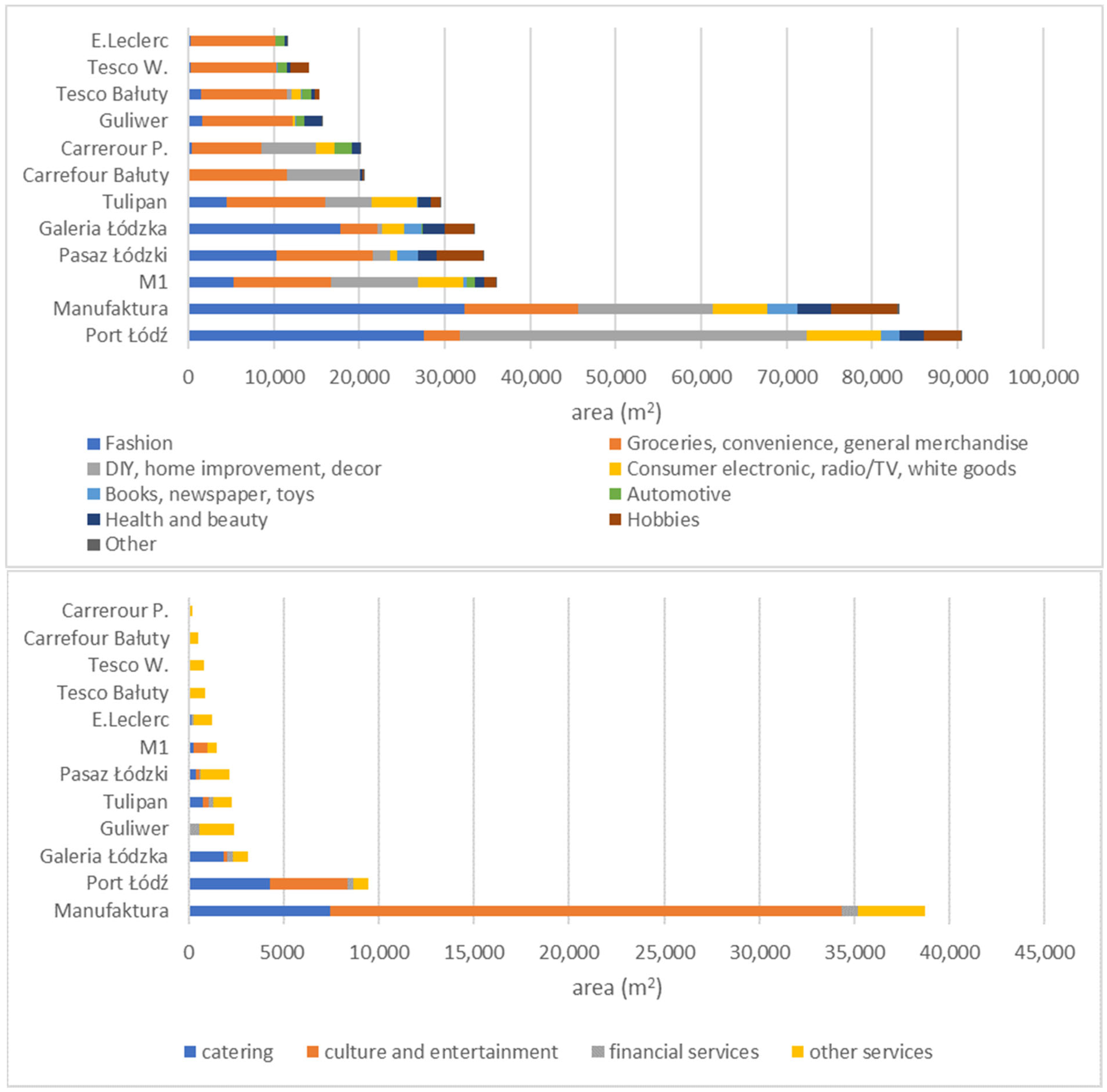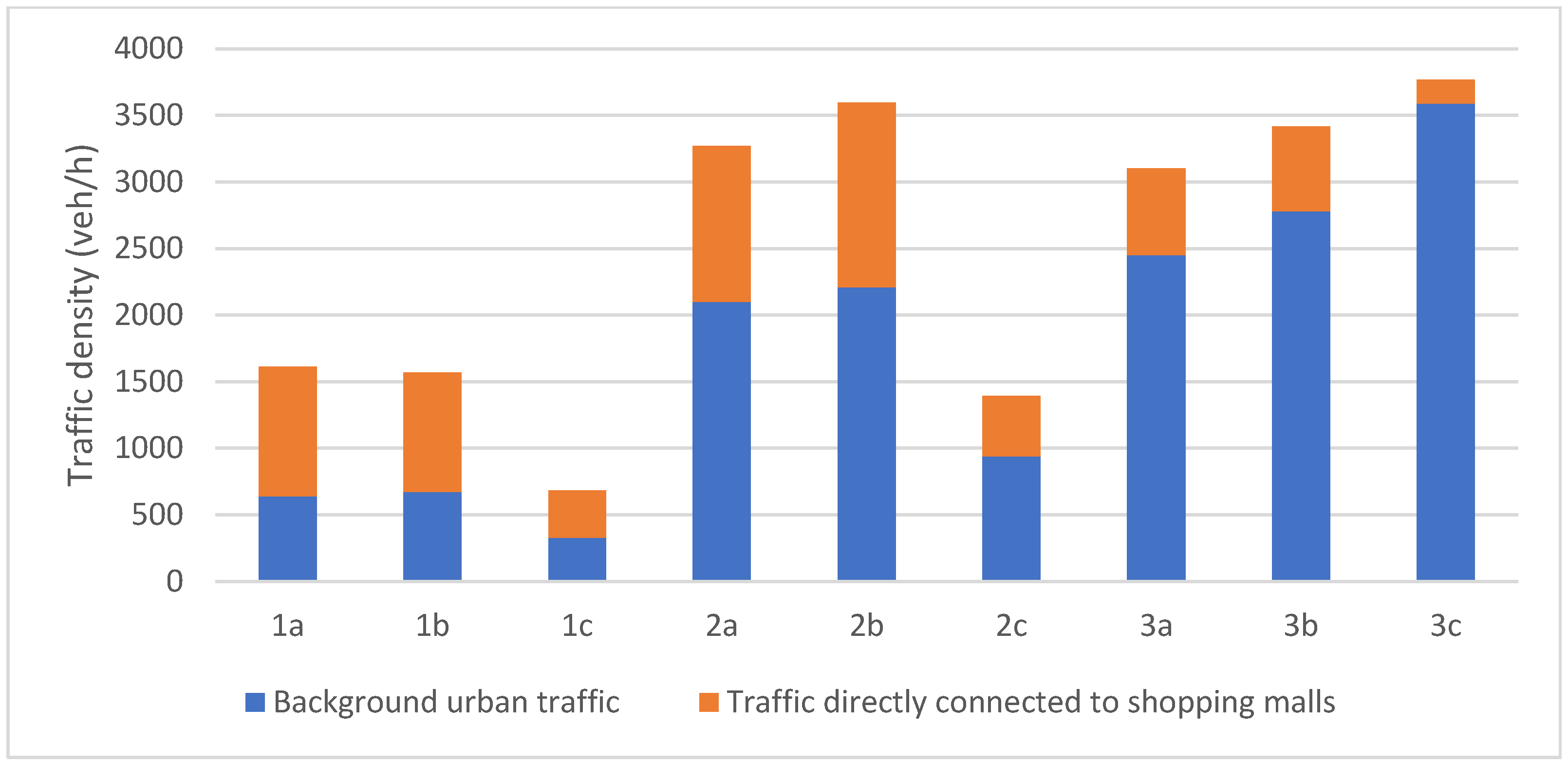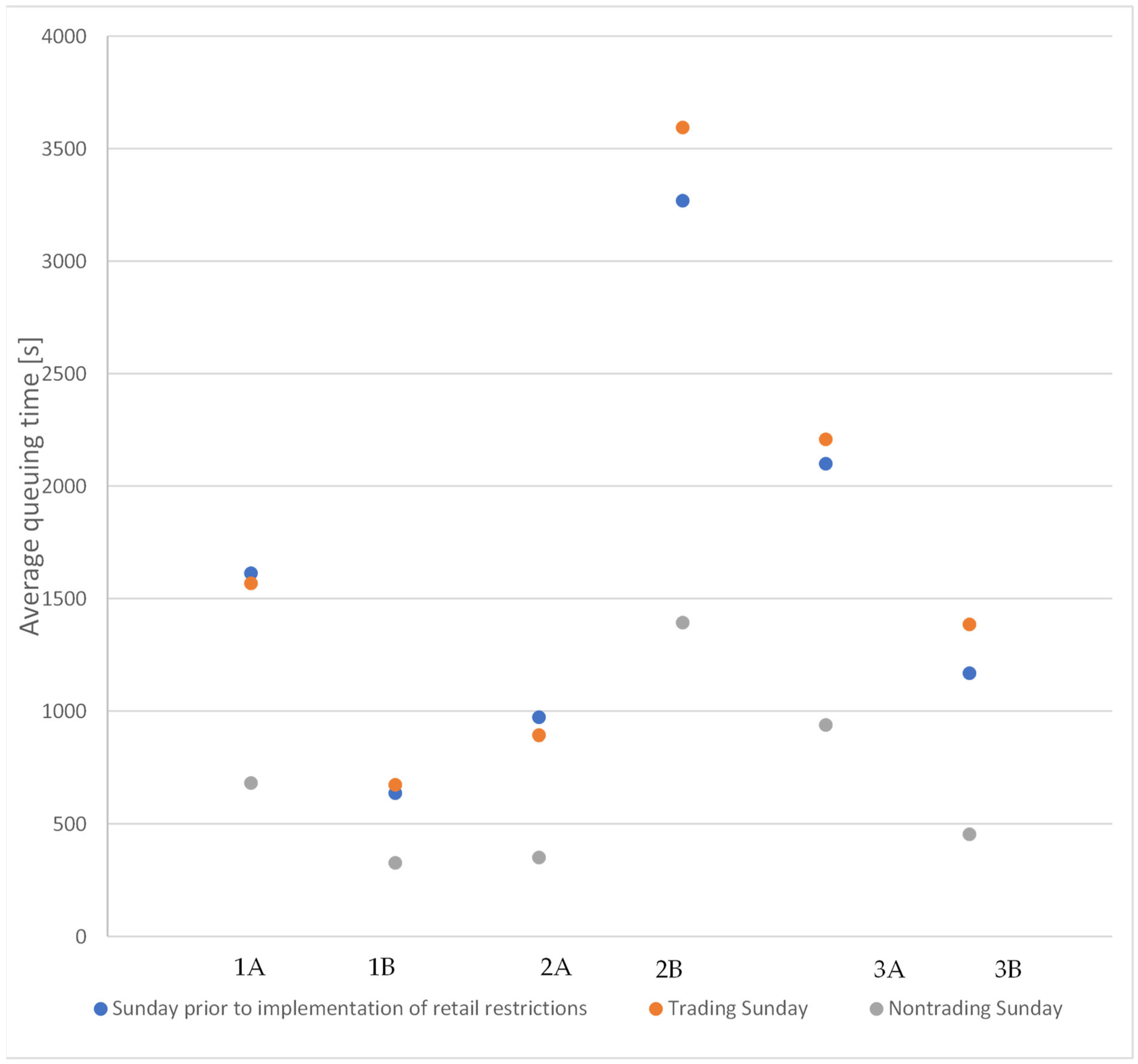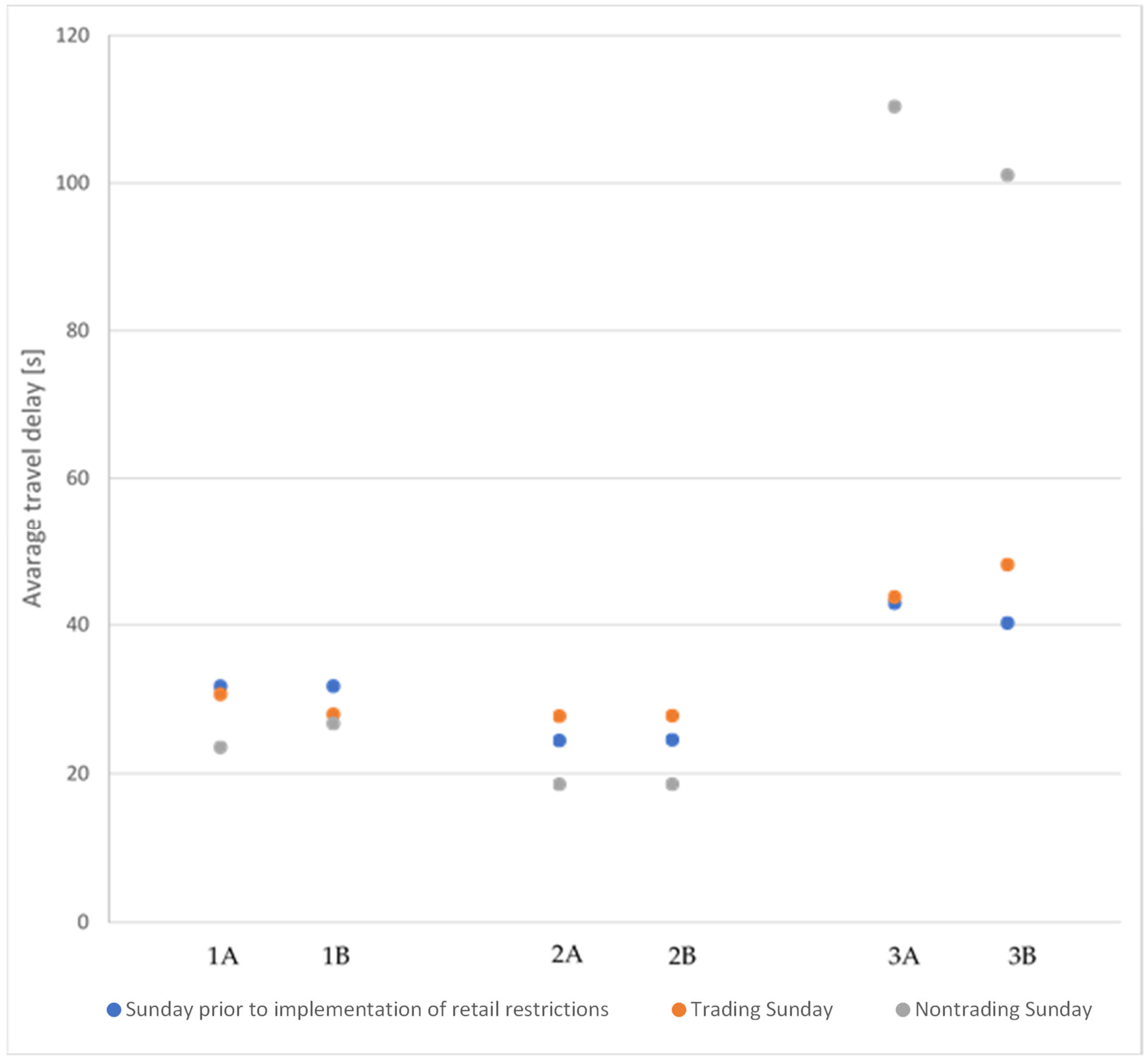Changes in Costs Incurred by Car Users of the Local Transport System Due to the Implementation of Sunday Retail Restrictions
Abstract
1. Introduction
2. Review of the Literature
2.1. Theoretical Foundations
2.2. Research Area
3. Source Materials and the Research Method
4. Results and Conclusions
Author Contributions
Funding
Institutional Review Board Statement
Informed Consent Statement
Data Availability Statement
Conflicts of Interest
References
- Zhang, Y.; Zhao, P.; Lin, J.-J. Exploring shopping travel behavior of millennials in Beijing: Impacts of built environment, life stages, and subjective preferences. Transp. Res. Part A Policy Pract. 2021, 147, 49–60. [Google Scholar] [CrossRef]
- Guy, C. ‘Sustainable transport choices’ in consumer shopping: A review of the UK evidence. Int. J. Consum. Stud. 2009, 33, 652–658. [Google Scholar] [CrossRef]
- Wiese, A.; Zielke, S.; Toporowski, W. Shopping travel behaviour. Int. J. Retail Distrib. Manag. 2015, 43, 469–484. [Google Scholar] [CrossRef]
- Dieleman, F.M.; Dijst, M.; Burghouwt, G. Urban Form and Travel Behaviour: Micro-level Household Attributes and Residential Context. Urban Stud. 2002, 39, 507–527. [Google Scholar] [CrossRef]
- George, P.; Kattor, G.J. Forecasting Trip Attraction Based on Commercial Land Use Characteristics. Int. J. Res. Eng. Technol. 2013, 2, 471–479. [Google Scholar] [CrossRef][Green Version]
- Szczuraszek, T.; Karwasz, M. Transport attractiveness of shopping malls. Tech. Trans. 2018, 7, 101–112. [Google Scholar] [CrossRef][Green Version]
- Szarata, A. Modelowanie liczby pojazdów generowanych przez duże centra handlowe. Pr. Nauk. Politech. Warsz. Transp. 2013, 97, 499–508. [Google Scholar]
- Eger, L.; Komárková, L.; Egerová, D.; Mičík, M. The effect of COVID-19 on consumer shopping behaviour: Generational cohort perspective. J. Retail. Consum. Serv. 2021, 61, 102542. [Google Scholar] [CrossRef]
- Laato, S.; Islam, A.K.M.N.; Farooq, A.; Dhir, A. Unusual purchasing behavior during the early stages of the COVID-19 pandemic: The stimulus-organism-response approach. J. Retail. Consum. Serv. 2020, 57, 102224. [Google Scholar] [CrossRef]
- Borowska-Stefańska, M.; Kowalski, M.; Kurzyk, P.; Sahebgharani, A.; Wiśniewski, S. Spatiotemporal Changeability of the Load of the Urban Road Transport System under Permanent and Short-Term Legal and Administrative Retail Restrictions. Sustainability 2022, 14, 5137. [Google Scholar] [CrossRef]
- Goos, M. Sinking the Blues: The Impact of Shop Closing Hours on Labor and Product Markets; Centre for Economic Performance, London School of Economics and Political Science: London, UK, 2004. [Google Scholar]
- Bossler, M.; Oberfichtner, M. The Employment Effect of Deregulating Shopping Hours: Evidence from German Food Retailing. Econ. Inq. 2017, 55, 757–777. [Google Scholar] [CrossRef]
- Genakos, C.; Danchev, S. Evaluating the Impact of Sunday Trading Deregulation; Centre for Economic Performance: London, UK, 2015. [Google Scholar]
- Grzesiuk, A. Sunday Trading Ban in Poland: Reflection After Three Years. Eur. Res. Stud. J. 2021, 24, 233–242. [Google Scholar] [CrossRef]
- Borowska-Stefańska, M.; Kowalski, M.; Wiśniewski, S. Changes in urban transport behaviours and spatial mobility resulting from the introduction of statutory Sunday retail restrictions: A case study of Lodz, Poland. Morav. Geogr. Rep. 2020, 28, 29–47. [Google Scholar] [CrossRef]
- GUS. Badanie Pilotażowe Zachowań Komunikacyjnych Ludności w Polsce; Główny Urząd Statystyczny: Warsaw, Poland, 2015. [Google Scholar]
- Hagberg, J.; Holmberg, U. Travel modes in grocery shopping. Int. J. Retail Distrib. Manag. 2017, 45, 991–1010. [Google Scholar] [CrossRef]
- Faishal Ibrahim, M. Car ownership and attitudes towards transport modes for shopping purposes in Singapore. Transportation 2003, 30, 435–457. [Google Scholar] [CrossRef]
- Borowska-Stefańska, M.; Dulebenets, M.A.; Horňák, M.; Kowalski, M.; Kozłowski, D.; Turoboś, F.; Wisniewski, S. The effect of Sunday shopping restriction on urban mobility patterns in the light of questionnaire research and ITS data. 2022; in review. [Google Scholar]
- Mešić, I. Concentration of the Retail Trade. In Proceedings of the 15th International Scientific Conference: Business Logistics in Modern Management, Osijek, Croatia, 15 October 2015; Faculty of Economics in Osijek: Osijek, Croatia, 2015; pp. 53–64. [Google Scholar]
- O’Kelly, M.E. A Model of the Demand for Retail Facilities, Incorporating Multistop, Multipurpose Trips. Geogr. Anal. 1981, 13, 134–148. [Google Scholar] [CrossRef]
- Hanson, S. lmplications for Choice Theory. Geogr. Anal. 1980, 12, 245–257. [Google Scholar] [CrossRef]
- Uddin, M.M.; Hasan, M.R.; Ahmed, I.; Das, P.; Uddin, M.A.; Hasan, T. A comprehensive study on trip attraction rates of shopping centers in Dhanmondi area. Int. J. Civ. Environ. Eng. 2012, 12, 12–16. [Google Scholar]
- Cubukcu, K.M. Factors Affecting Shopping Trip Generation Rates in Metropolitan Areas. Stud. Reg. Urban Plan. 2001, 9, 51–68. [Google Scholar]
- Arentze, T.A.; Oppewal, H.; Timmermans, H.J.P. A multipurpose shopping trip model to assess retail agglomeration effects. J. Mark. Res. 2005, 42, 109–115. [Google Scholar] [CrossRef]
- Romanowska, A.; Jamroz, K. Wielkopowierzchniowe obiekty handlowe: Zwykłe generatory ruchu czy źródła problemów transportowych? Transp. Miej. I Reg. 2015, 2, 4–13. Available online: http://yadda.icm.edu.pl/baztech/element/bwmeta1.element.baztech-8c5ad3be-8190-4570-8e03-fb14c4b4412a (accessed on 23 August 2022).
- Kowalski, M.; Wiśniewski, S. Centrum handlowe jako czynnik ruchotwórczy w transporcie samochodowym—Przykład Portu Łódź. Przegląd Geogr. 2017, 89, 617–639. [Google Scholar] [CrossRef]
- Chmielewski, J. Impact of Sunday Trade Ban on Traffic Volumes. In Scientific and Technical Conference Transport Systems Theory and Practice, Proceedings of the TSTP 2019: Modern Traffic Engineering in the System Approach to the Development of Traffic Networks, Katowice, Poland, 16–18 September 2019; Springer: Cham, Switzerland, 2019; pp. 231–241. [Google Scholar]
- Dijkgraaf, E.; Gradus, R. Explaining sunday shop policies. Economist 2007, 155, 207–219. [Google Scholar] [CrossRef]
- Dijkgraaf, E.; Gradus, R. Deregulating Sunday Shop Policies. 2006. Available online: https://ssrn.com/abstract=875322 (accessed on 23 August 2022).
- Tanguay, G.A.; Vallge, L.U.C.; Lanoie, P. Shopping hours and price levels in the retailing industry: A theoretical and empirical analysis. Econ. Inq. 1995, 33, 516–524. [Google Scholar] [CrossRef]
- de Meza, D. The Fourth Commandment: Is it Pareto Efficient? Econ. J. 1984, 94, 379–383. [Google Scholar] [CrossRef]
- Borowska-Stefańska, M.; Kowalski, M.; Wiśniewski, S.; Szustowski, B.; Maczuga, M. The impact of statutory sunday trading restrictions… on the choices of residents of a large polish city with regard to transport behaviours and mobility. Stud. Reg. I Lokal. 2020, 82, 33–59. [Google Scholar] [CrossRef]
- Borowska-Stefańska, M.; Kowalski, M.; Kurzyk, P.; Sahebgharani, A.; Sapińska, P.; Wiśniewski, S.; Goniewicz, K.; Dulebenets, M.A. Assessing the Impacts of Sunday Trading Restrictions on Urban Public Transport: An Example of a Big City in Central Poland. 2022; under review. [Google Scholar]
- Twardzik, M. Typologia i znaczenie centrów handlowych dla miast województwa śląskiego. Stud. Miej. 2014, 16, 129–145. [Google Scholar] [CrossRef]
- Rochmińska, A. Centra handlowe-miejsca spędzania czasu wolnego przez łodzian. Acta Univ. Lodz. Folia Geogr. Socio-Oeconomica 2011, 11, 1–12. [Google Scholar]
- Rembowska, K. Kulturowy aspekt przemian rynku usług. Sp.-Soc.-Econ. 2008, 8, 5–15. [Google Scholar]
- Adamiec, J.; Grodzka, D. Społeczne uwarunkowania handlu w niedziele. Infos 2017, 224, 1–4. [Google Scholar]
- Borowska-Stefańska, M.; Kowalski, M.; Wiśniewski, S.; Kurzyk, P. Spatial Dimension of Transport Exclusion Related to Statutory Trade Restriction—The Use of ITS Tools in Studies of Sustainable Urban Development. Remote Sens. 2021, 13, 4804. [Google Scholar] [CrossRef]
- Borowska-Stefańska, M.; Andrzejczak, G.; Turoboś, F.; Horňák, M.; Dulebenets, M.A.; Wiśniewski, S. Patterns of transport and consumer behaviour among residents of a large city with regard to Sunday retail restrictions. 2022; under review. [Google Scholar]
- Borowska-Stefańska, M.; Kowalski, M.; Wiśniewski, S. Wewnętrzna samochodowa dostępność transportowa Łodzi w świetle pomiarów z inteligentnych systemów transportowych. Pr. Geogr. 2019, 159, 7–24. [Google Scholar] [CrossRef]
- Wiśniewski, S. Teoretyczna i rzezcywista wewnętrzna dostępność transportowa Łodzi. Pr. I Stud. Geogr. 2016, 61, 95–108. [Google Scholar]
- Błażej Seweryn Grzelak. Aktualizacja studium systemu transportowego dla miasta Łodzi; Urząd Miasta Łodzi: Łódź, Poland, 2013. [Google Scholar]
- Borowska-Stefańska, M.; Dulebenets, M.A.; Kowalski, M.; Masierek, E.; Wiśniewski, S. Transport Behaviour of Residents in the City of Lodz (Poland). 2022; under review. [Google Scholar]
- Kowalski, M.; Wiśniewski, S. Dostępność transportowa łódzkich centrów handlowych. Handel Wewnętrzny 2017, 3, 339–357. [Google Scholar]
- Borowska-Stefańska, M.; Kowalski, M.; Kurzyk, P.; Mikušová, M.; Wiśniewski, S. Application of Intelligent Transportation Systems in Analyses of Human Spatial Mobility in Cities. Pr. Kom. Geogr. Komun. PTG 2021, 24, 7–30. [Google Scholar] [CrossRef]
- Zhu, M.; Wang, X.; Tarko, A.; Fang, S. Modeling car-following behavior on urban expressways in Shanghai: A naturalistic driving study. Transp. Res. Part C Emerg. Technol. 2018, 93, 425–445. [Google Scholar] [CrossRef]
- Saifuzzaman, M.; Zheng, Z. Incorporating human-factors in car-following models: A review of recent developments and research needs. Transp. Res. Part C Emerg. Technol. 2014, 48, 379–403. [Google Scholar] [CrossRef]
- Panwai, S.; Dia, H. Comparative evaluation of microscopic car-following behavior. IEEE Trans. Intell. Transp. Syst. 2005, 6, 314–325. [Google Scholar] [CrossRef]
- Olstam, J.J.; Tapani, A. Comparison of Car-Following Models; Swedish National Road and Transport Research Institute: Linköping, Sweden, 2004. [Google Scholar]
- Borowska-Stefańska, M.; Mikusova, M.; Kowalski, M.; Kurzyk, P.; Wiśniewski, S. Changes in Urban Mobility Related to the Public Bike System with Regard to Weather Conditions and Statutory Retail Restrictions. Remote Sens. 2021, 13, 3597. [Google Scholar] [CrossRef]
- Rochmińska, A. Atrakcyjność Łódzkich Centrów Handlowych Oraz Zachowania Nabywcze I Przestrzenne Ich Klientów; Wydawnictwo Uniwersytetu Łódzkiego: Łódź, Poland, 2013. [Google Scholar]







| Name | GLA (m2) | Size * | Generation | Catchment Area ** | Location |
|---|---|---|---|---|---|
| Manufaktura | 125.7 | Medium | II | Local | City centre |
| Port Lodz | 103 | Very large | III | Supraregional | Suburbia |
| Tulipan | 33.2 | Very large | IV | Supraregional | Axis: city centre—large residential area |
| Manufaktura | Port Lodz | Tulipan | |
|---|---|---|---|
| Change in traffic density created by shopping centres for February 2019 versus February 2018 [%] | |||
| nontrading Sundays | −64% | −61% | −72% |
| trading Sundays | −8% | 19% | −2% |
| Change in traffic density unrelated to shopping centres for February 2019 versus February 2018 [%] | |||
| nontrading Sundays | −49% | −55% | 47% |
| trading Sundays | 5% | 5% | 14% |
Publisher’s Note: MDPI stays neutral with regard to jurisdictional claims in published maps and institutional affiliations. |
© 2022 by the authors. Licensee MDPI, Basel, Switzerland. This article is an open access article distributed under the terms and conditions of the Creative Commons Attribution (CC BY) license (https://creativecommons.org/licenses/by/4.0/).
Share and Cite
Borowska-Stefańska, M.; Kowalski, M.; Majewska, A.; Wiśniewski, S. Changes in Costs Incurred by Car Users of the Local Transport System Due to the Implementation of Sunday Retail Restrictions. Sustainability 2022, 14, 13383. https://doi.org/10.3390/su142013383
Borowska-Stefańska M, Kowalski M, Majewska A, Wiśniewski S. Changes in Costs Incurred by Car Users of the Local Transport System Due to the Implementation of Sunday Retail Restrictions. Sustainability. 2022; 14(20):13383. https://doi.org/10.3390/su142013383
Chicago/Turabian StyleBorowska-Stefańska, Marta, Michał Kowalski, Anna Majewska, and Szymon Wiśniewski. 2022. "Changes in Costs Incurred by Car Users of the Local Transport System Due to the Implementation of Sunday Retail Restrictions" Sustainability 14, no. 20: 13383. https://doi.org/10.3390/su142013383
APA StyleBorowska-Stefańska, M., Kowalski, M., Majewska, A., & Wiśniewski, S. (2022). Changes in Costs Incurred by Car Users of the Local Transport System Due to the Implementation of Sunday Retail Restrictions. Sustainability, 14(20), 13383. https://doi.org/10.3390/su142013383











